Boston Globe: At the Portland Museum of Art, the gift of ‘Presence’
5 min read
The museum celebrates a major photographic acquisition with selections from the collection of Judy Glickman Lauder
By Mark Feeney Globe Staff
Updated November 15, 2022, 2:49 p.m.
This article originally appears in the Boston Globe.
Richard Avedon, “Audrey Hepburn and Art Buchwald, with Simone D’Aillencourt, Frederick Eberstadt, Barbara Mullen, and Dr. Reginald Kernan,evening dresses by Balmain, Dior, and Patou, Maxim’s, Paris, August 1959.” RICHARD AVEDON/PORTLAND MUSEUM OF ART, MAINE, JUDY GLICKMAN LAUDER COLLECTION. © THE RICHARD AVEDON FOUNDATION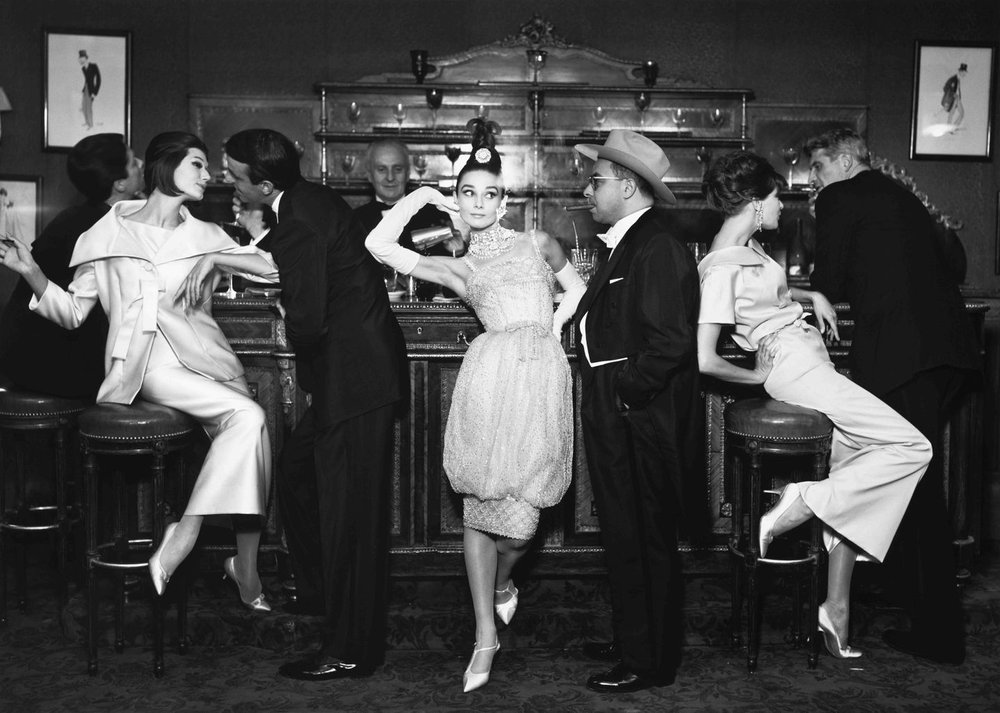
PORTLAND — The quality and variety of the photographs in any given collection determine whether the collection is worth looking at. That’s pretty obvious. What’s less obvious is that the character of the collector determines whether that collection is worth thinking about. It’s one thing to look at pictures when they’re in front of you. It’s quite another to have them stay in your mind’s eye.
Character isn’t necessarily the same thing as taste. Taste, a component of character, is a limiting condition. Which is as it should be: Taste always has even more to do with leaving out than putting in. Character is inherently expansive — and unpredictable — just the way people are.
Max Yavno, “Cable Car, San Francisco,” 1947 IMAGE COURTESY LUC DEMERS. © CENTER FOR CREATIVE PHOTOGRAPHY, UNIVERSITY OF ARIZONA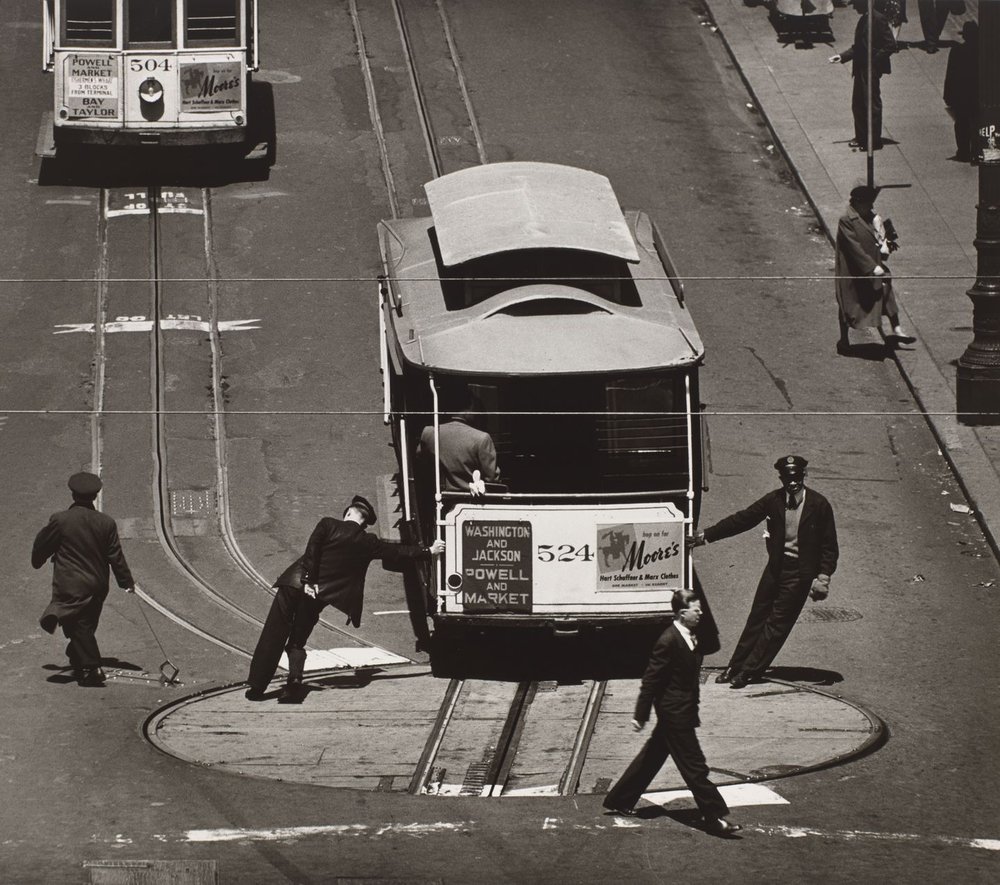
What inspires these observations is “Presence: The Photography Collection of Judy Glickman Lauder.” It runs at the Portland Museum of Art through Jan. 15. The PMA’s Anjuli Lebowitz curated the show.
“Presence” consists of nearly 150 photographs, which is about a fifth of the gift (speaking of “given collections”) that Glickman Lauder has promised the museum. That’s a lot of photographs, both in the show proper and the collection overall. Seventy photographers are represented in “Presence,” running from A — Abbott (Berenice), Arbus (Diane), Avedon (Richard) — to Zee (James Van Der). As those names suggest, there’s a lot of quality within all that quantity.
James Van Der Zee, “Kate and Rachel Van Der Zee, Lenox, Massachusetts,” 1909 IMAGE COURTESY LUC DEMERS. © JAMES VAN DER ZEE ARCHIVE, THE METROPOLITAN MUSEUM OF ART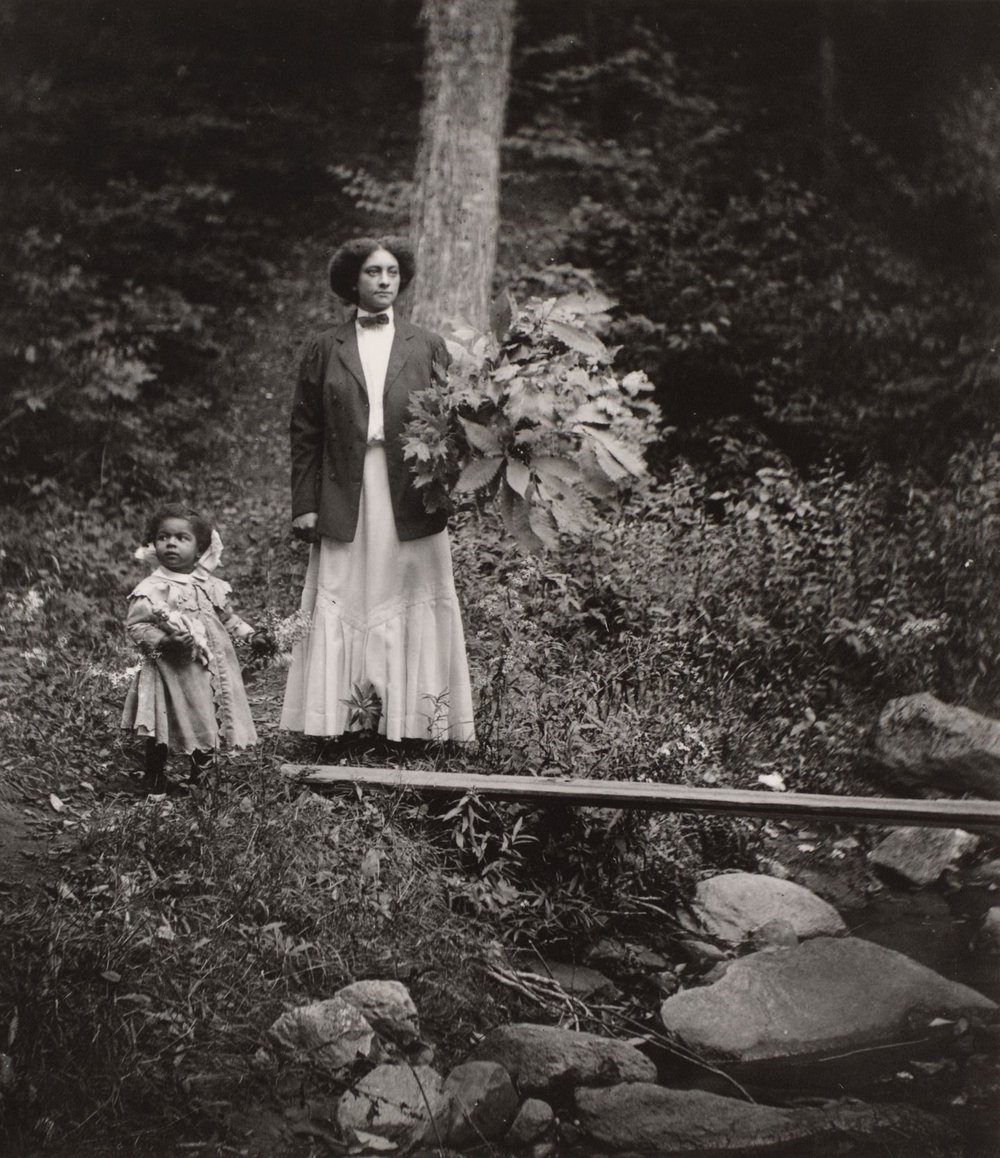
“Presence” includes numerous other famous photographic names: Henri Cartier-Bresson, Gordon Parks, Sebastião Salgado, Paul Strand, Edward Weston, Garry Winogrand. There are famous photographs as well, images you would recognize even if you’re not familiar with the photographer or title: Avedon’s portrait of a robotic-looking Marilyn Monroe (1957), Lewis Hine’s “Power House Mechanic” (1920), James Karales’s “Selma to Montgomery March, Alabama” (1965), Dorothea Lange’s “Migrant Mother” (1936), Weegee’s “The Critic” (1943).
Close looking is often rewarded. Avedon’s 1969 group portrait of the Chicago Seven hangs across from his 1971 group portrait of US military and diplomatic leaders in Saigon. Even if photographs had the power of speech, those two would not be on speaking terms.
There’s a 1983 image from Nan Goldin’s “The Ballad of Sexual Dependency.” That landmark series takes its title from a song in Brecht-Weill’s “Threepenny Opera.” The photograph is near a Lotte Jacobi portrait of Lotte Lenya (1929). Lenya was married to Kurt Weill and starred in the original production of the musical. It’s a nicely subtle bit of affiliation.
On an adjoining wall hang to the Monroe portrait, Horst’s “Mainbocher Corset, Paris” (1939), and one of Susan Meiselas’s photographs of a Vermont carnival strip show (1973). The lessons to be pondered on the uses to which men put female sexuality are all the more profound for going unstated.
The show is divided into seven categories, including portraits, landscape, cities. The divisions among the categories are usefully porous. How to distinguish, for instance, between “Politics, Hope, and Despair” and “Freedom, Justice, and Dignity”? Those two titles do indicate how strongly themes of social justice figure in “Presence.”
Melonie Bennett, “Suzie, Bahama Beach Club, Portland, Maine,” 1996 IMAGE COURTESY LUC DEMERS. © MELONIE BENNETT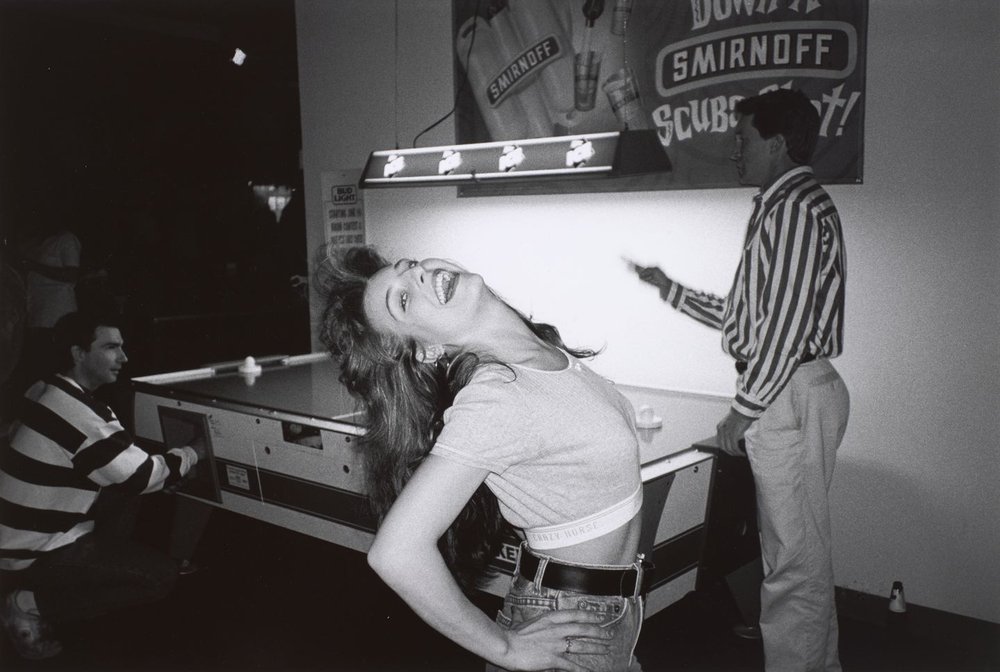
A preference for such subject matter is an example of where character comes into play. Others are less pronounced. Fittingly, Maine figures throughout the show. There are Maine photographers. Melonie Bennett has three photographs in “Presence.” Joyce Tenneson and Tonee Harbert have one each. Harbert’s “Jamaican Apple Pickers, Bridgton, Maine,” from 1988, is an example of porousness. It qualifies as landscape and could fit into either of the social-justice categories.
The three Abbotts in the show are from her magnificent “Changing New York” series, but she lived the final decades of her life in Maine. So she qualifies as a local. So does Todd Webb, another Maine transplant, who’s also represented by New York work, an eight-photograph sequence about a block in Midtown Manhattan, from 1948.
Portraits of artists appear throughout. There are painters: Arbus/Agnes Martin, (1966); Cartier-Bresson/Matisse (1944); Duane Michals, with both Magritte (1965) and de Kooning (1985); Lola Alvarez Bravo/Frida Kahlo (1944); Webb/Georgia O’Keeffe (1964). There are photographers: Judy Dater/Imogen Cunningham (1974); Cunningham, /Weston and Margrethe Mather (a joint portrait, 1922); Edward Steichen (a self-portrait, circa 1920); Arnold Newman/Mary Ellen Mark (taken in Rockport, Maine, so add that to the Down East list, 1993), and a Newman joint portrait of Alfred Stieglitz and O’Keeffe (1944).
Norman Seeff, “Robert Mapplethorpe and Patti Smith, New York,” 1969 IMAGE COURTESY LUC DEMERS. © PHOTOGRAPH BY NORMAN SEEFF.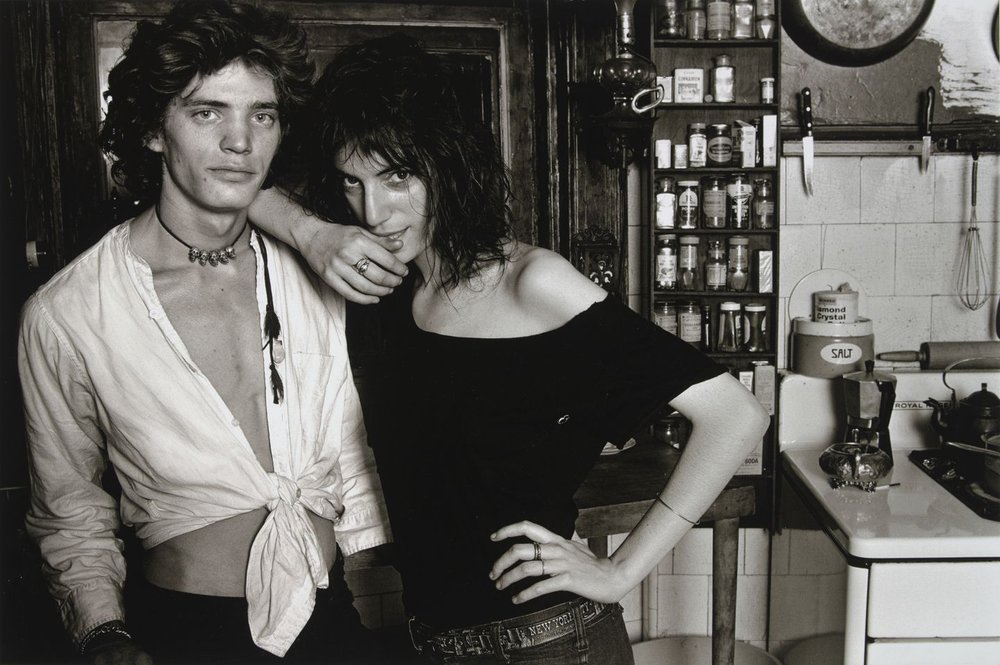
Norman Seeff’s 1969 joint portrait of Robert Mapplethorpe and Patti Smith is in the artist-portrait category — don’t forget, Smith’s a pretty good photographer, too — but also belongs in another: rock stars. The latter include Graham Nash (a self-portrait, 2001), Bob Dylan (Danny Lyon, 1942), Elton John (Terry O’Neill, 1974), and Mick Jagger, with his wife, Bianca, on their wedding day (Patrick Lichfield, 1971).
There are also dancers. Steichen captures Isadora Duncan at the Parthenon (1921). Cornell Capa shows a Bolshoi rehearsal (1958). Barbara Morgan has two photographs of Martha Graham in performance (both 1935). Jacobi’s “Head of a Dancer” (1929) is performance as millinery: such a hat that woman is wearing! The most balletic images aren’t of dancers, per se. Max Yavno’s shot of trainmen turning around a San Francisco cable car (1947) and Mario Giacomelli’s two views of priests cavorting in the snow, their robes flowing, are as graceful as a Balanchine daydream (1961-63).
Mario Giacomelli, “Lo Non Ho Mani Mi Accarezzino Il Volto (There Are No Hands to Caress My Face),” 1961-63 IMAGE COURTESY LUC DEMERS. ARCHIVIO MARIO GIACOMELLI © SIMONE GIACOMELLI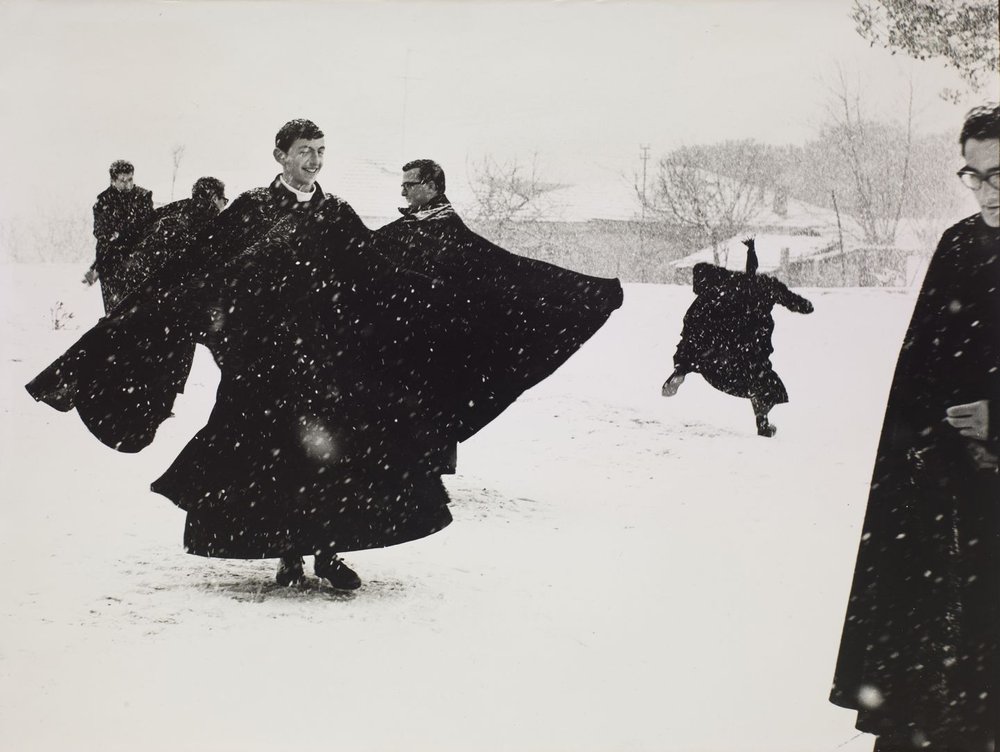
The photographers with the most images in the show are Paul Caponigro, with 14, and Irving Bennett Ellis, with 16. The Caponigros are from his “Stonehenge Portfolio” (1967-72). As befits their subject, they’re brooding, mystical, mystic. Ellis’s photographs, from his “Door Series,” could hardly differ more. They show his daughter standing in front of the entrance to the family home, one per year, from 1939-1953. They’re the photo-album equivalent of time-lapse photography. It doesn’t come as a surprise to learn that they were later used in a TV ad for Kodak film. The ad is part of “Presence,” too.
The inclusion of the Ellis photographs and ad seems incongruous, but this gets back to the matter of character in a collection. There’s certainly nothing rote or predictable about their being in “Presence.” That’s true, too, of the show including six photographs by Glickman Lauder. She’s a talented photographer, and one might argue that it would be unfair not to include her work in the show simply because she’s the donor. But it’s unfair in a different way to have one of her photographs next to, say, a Cartier-Bresson, as one of them, in fact, is. It takes a lot of character to stand up to a comparison like that.







